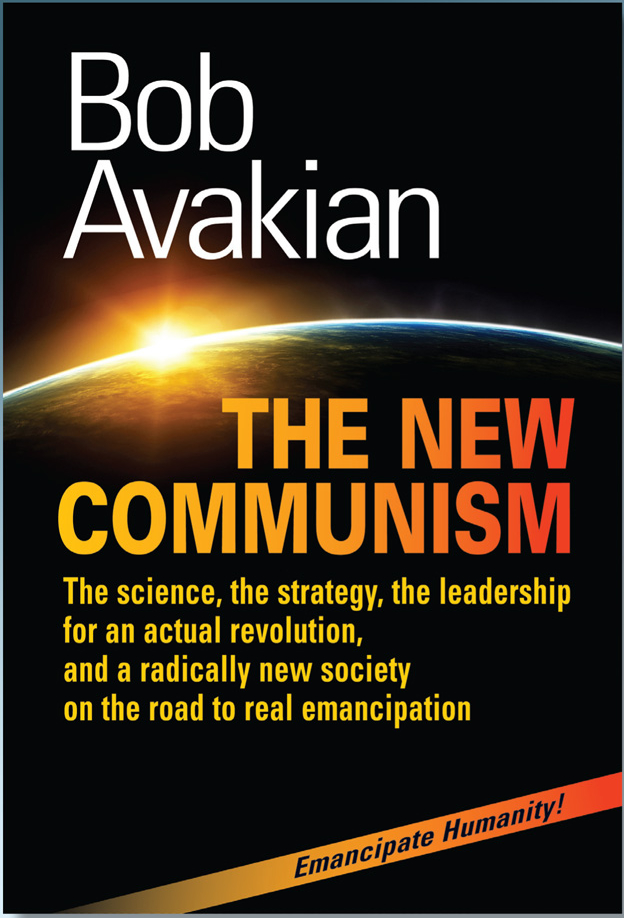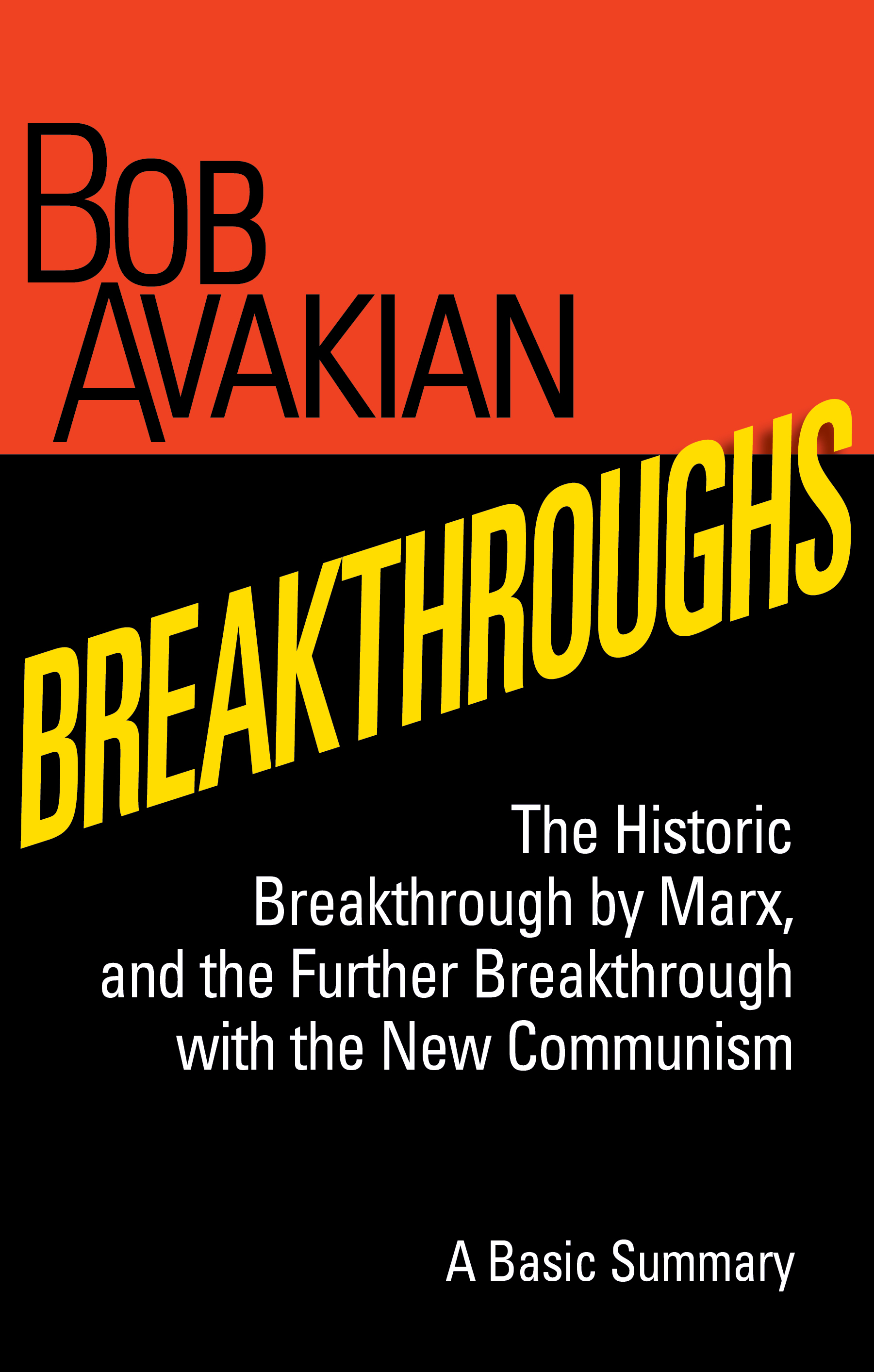COMMODITIES & CAPITALISM—AND THE TERRIBLE CONSEQUENCES OF THIS SYSTEM
A Basic Explanation
by Bob Avakian
| revcom.us
In a number of works, including Breakthroughs1 and The New Communism,2 I have examined the basic contradictions of the capitalist economy (mode of production) and the terrible consequences of the fact that the system of capitalism-imperialism continues to dominate the world. Here I want to offer a more brief, basic explanation of the contradictions inherent in (built into) this mode of production and how this leads to these terrible consequences.
Capitalism is the system where commodity production and exchange is generalized. A commodity is anything that is produced to be exchanged (sold). This is different than when someone produces something for their own use (and doesn’t exchange it with someone else). Understood in this way, a commodity can be either a good (such as clothes) or a service (such as health care). Under capitalism, goods and services are commodities.
Commodities have a basic contradiction built into them: the contradiction between use value and exchange value. Use value relates to the fact that, in order for a commodity to be exchanged for something else (sold), there must be someone (or numbers of people) who find this particular commodity useful (something they need or desire). Exchange value refers to the fact that the value of anything, as a commodity to be exchanged, is equal to the amount of socially necessary labor time that is required for the production of that thing. In illustrating this, I have used the example of a candy bar and an airplane. The reason that an airplane is much more valuable—contains much more exchange value—than a candy bar is fundamentally because the amount of socially necessary labor time that goes into producing an airplane is much greater than that required to produce a candy bar.3
In discussing this kind of thing, I have also used the example of chocolate chip cookies.4 If you make chocolate chip cookies with the idea of selling them, but no one finds them useful—people prefer other cookies or, for some reason, nobody wants cookies—then you will not be able to exchange (sell) them. In that situation, the exchange value of these cookies (what they can bring in return—money or some other commodity) cannot be realized, and the money you have spent in order to get the ingredients to make the cookies will be a loss for you. If this keeps up, you will go heavily into debt and eventually be forced to give up trying to sell your cookies (you will have to go out of business).
Here we see the basic contradiction between use value and exchange value being played out. Something must have use value in order to be exchanged; and if it does not have use value (if people do not find it useful, or find some other version of the same commodity, or some other commodity more useful), then it cannot be exchanged, and the owner of that thing (commodity) will suffer a loss.
As noted at the beginning, the capitalist system involves the generalization of commodity production and exchange. Overwhelmingly in capitalist society, things are produced to be exchanged (sold). And another defining feature of capitalism is that labor power (the ability to work in general) is also a commodity: People who are employed by others exchange this commodity of theirs (their labor power, their ability to work) for another commodity: money (a wage or salary) in order to live—in order to have the basis to buy still other commodities, such as food, clothing, etc.
The “secret” of capitalist development is that labor power is a special kind of commodity: It can create more wealth (value) in its use (by the employer—the capitalist) than the amount of value that is equal to what is paid to the worker in the form of a wage (or salary). So what, in its outward appearance, seems to be “an equal exchange”—a wage or salary for work—is actually an unequal exchange. The person employed does not work only the amount of time in which they produce value equal to their wage (or salary); they must work a number of additional hours producing additional value—surplus value—which is accumulated (appropriated) by their employer, the capitalist. If they are not willing to do this, they will be fired—or not hired in the first place.
This is the source of capitalist profit, and it represents the basic exploitative relation of capitalism—a system in which ultimately billions of people are employed by a relatively small number of capitalists, with corporations and other big associations of capital dominating the economy and accumulating huge amounts of profit every year. And this exploitation is part of the fundamental contradiction of capitalism—the contradiction between socialized production and private appropriation—the fact that production is actually carried out in a highly socialized manner, often with thousands of people working together in various workplaces to produce the commodities that are to be sold (whether food, clothes, shoes, cars, soccer balls, or other products) which, in turn, is part of an overall system of production involving millions and ultimately billions of people, while the products of this labor (the commodities) are appropriated privately and sold by capitalists who do not carry out the labor to produce these commodities but employ others to do so.
This relation between the capitalists (the bourgeoisie) and those they exploit (the proletariat) is one of the driving forces of the capitalist system. The other, even more decisive, driving force is the anarchy of this system. This goes back to the basic contradiction between use value and exchange value. In order to carry out the production of the products they aim to sell, the capitalists must spend money (invest) in buying labor power (employing people for a wage or salary), as well as raw materials, machinery and other means of production. Yet, even with all their “market studies” and other attempts to calculate how to “realize a profitable return” on their investment, these capitalists are in competition with other capitalists, and there is no guarantee that they will be able to achieve a profitable return on, or even that they will be able to “recoup” (get back an amount equal to) what they have invested. This is why they spend huge sums on advertising, in the attempt to convince “consumers” that their product is the most useful. And if they do not succeed in convincing enough “consumers” to buy their product, then they will not be able to realize the exchange value embodied in their products—they will fail to get a “profitable return,” or perhaps even to “break even,” on their investment; and if this continues, they will lose out to other capitalists, and may eventually “go under” altogether. This is the driving force that leads the capitalists to constantly seek out situations where they can exploit people even more intensely—employing people at lower wages, such as the actual (or near) starvation wages they pay people, including children, that they employ in sweatshops and mines in the Third World (Latin America, Africa, the Middle East and Asia).
The fact that competition among the capitalists, and the anarchy involved in it, takes place now on a massive scale—involving production and exchange on a global level, with the capitalists needing to constantly find cheaper sources of “inputs” (including people to exploit as well as raw materials) regardless of the cost to human beings and the environment—this means that the destruction caused by this is also on a massive, and continually expanding, scale. And, as explained by Raymond Lotta in a very important article:
The heightened imperialist globalization of production refers to the fact that a qualitatively greater share of industrial production serving the profit‑making requirements of imperialist capital is carried out in wider parts of the world, outside the “home” (the domestic) market of the imperialist economies—even though the national‑home market remains the single largest market and is the base of the national‑imperialist capital of countries like the U.S., Japan, Germany, Russia, etc. This heightened globalization is an expression of the expand‑or‑die logic of capitalism‑imperialism and the rivalry among imperial powers.5
In turn, the defining contradictions of this system of capitalism-imperialism, including rivalry among imperialist powers, leads repeatedly to wars. This includes wars by imperialists to subjugate countries in the Third World (such as the U.S. war against Iraq), in order to achieve (or maintain) control of key sources of raw materials and people to exploit, domination of strategic parts of the world and a dominant position in the world as a whole. There are also “proxy wars” in which rival imperialist powers back other, less powerful countries in such wars. And the possibility cannot be ruled out of war between rival imperialist powers themselves, with all the destruction this would involve, and the very real threat to the existence of humanity.
With all the complexity involved, all this is ultimately grounded in that basic contradiction inherent in commodities—between use value and exchange value—and the ways this finds expression with the capitalist mode of production that leads to terrible consequences for humanity and its future. It is this basic contradiction, and everything bound up with it and flowing out of it, that the socialist revolution, with its final goal of a communist world, can put an end to, by moving to eliminate the private ownership of the means of production and private appropriation of the products of production, and bringing about the eventual elimination of the production of things as commodities—and, in place of that, marshaling the productive forces of society, in a socialized and planned way, to produce things on the basis of what is useful in meeting the needs of the masses of people and ultimately all of humanity, and distributing this to the people on the basis of need, not on the basis of exchange value.
This will make it possible—this will provide the material foundation—for a whole new era in human history, with whole new relations among people, fundamentally based on cooperation not competition, and with the corresponding ideas and values.
1. Breakthroughs: The Historic Breakthrough by Marx, and the Further Breakthrough with the New Communism, A Basic Summary, by Bob Avakian, published as an eBook by Insight Press (insight‑press.com), is available online at Amazon, Apple Books, Barnes & Noble, Kobo and other major retailers (EPUB, MOBI, PDF). It can also be accessed at revcom.us. [back]
2. The book by Bob Avakian, The New Communism: The science, the strategy, the leadership for an actual revolution, and a radically new society on the road to real emancipation, is also available through Insight Press. Excerpts from this book are available at revcom.us. [back]
3. The reference here (with the example of the different values of an airplane and a candy bar) is to Making Revolution and Emancipating Humanity, by Bob Avakian, Part 1: “Beyond the Narrow Horizon of Bourgeois Right,” in the section “Marxism as a Science—Refuting Karl Popper.” [back]
4. This example of chocolate chip cookies, in explaining the basic dynamics of capitalism, is found in the 2003 talk by Bob Avakian, Revolution: Why It's Necessary, Why It's Possible, What It's All About. The film of this talk is available at revcom.us/BA’s Collected Works. [back]
5. Imperialist Parasitism and Class‑Social Recomposition in the U.S. From the 1970s to Today: An Exploration of Trends and Changes, by Raymond Lotta, is available at revcom.us. [Italics in the original, underlining added here.] [back]

THE NEW COMMUNISM
The science, the strategy, the leadership for an actual revolution, and a radically new society on the road to real emancipation, by Bob Avakian
Get a free email subscription to revcom.us:


